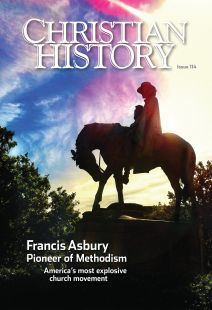Methodists and their stuff
Methodists are known for keeping track of their history—and of themselves. Since their start in the eighteenth century, they have produced and collected thousands of documents and objects, published records of annual meetings, and preserved artifacts personally attached to their founders and other well-known Methodists. Why do people save things? The act of collecting objects and showcasing pieces from the past allows contemporary viewers to peer into days gone by, to gaze at historic locations, and to connect with the ways our forebears taught, preached, and played.
For example, Bishop Richard Allen, founder of the African Methodist Episcopal Church (see “My chains fell off,” p. 21) served as the minister of “Mother Bethel” AME Church in Philadelphia. Mother Bethel houses a museum spotlighting artifacts historically connected to Allen including a well-worn leather Bible and a wooden pulpit. Visitors can also linger in the presence of the actual bodies of Richard and Sarah Allen, entombed in a room of the museum since the early twentieth century.
The United Methodist Archives Center in New Jersey has an original Bible used by early revivalist George Whitefield and keeps a bone fragment supposedly of his thumb on display. The thumb, at the center since 1982, is one of the things people who visit the building most often request to see.
Several items intimately tied to Francis Asbury also reside at St. George’s United Methodist Church in Philadelphia, the World Methodist Museum in North Carolina, and at the Methodist Center in New Jersey: a personal hair comb, several pairs of eyeglasses, a pocket watch, a pen knife for shaving quills, a trunk, saddlebags, a communion chalice, and a powder horn inscribed with Asbury’s name.
Methodists even preserved a peg from a church wall where Asbury once hung his coat and a piece of rock on which Asbury apparently sat one day.
These artifacts help Methodists create shared identity and denominational memory, document the movement’s authenticity, and provide opportunities to reflect upon and remember the past. They become literal pieces of history, housed, viewed, and venerated by contemporary Methodists across the United States.
By Christopher J. Anderson
[Christian History originally published this article in Christian History Issue #114 in 2015]
Christopher J. Anderson, head of Special Collections and University Archives and Methodist Librarian at the United Methodist Archives and History Center in Madison, New Jersey.Next articles
The “Church of the Horse”
What was it like to be an American Methodist when Francis Asbury was alive?
Lester RuthCamp meetings: a Methodist invention?
Revival elements people experienced in 1801 had been part of Methodist life for several decades
Lester RuthThe bishop and his mentor
The saintly German leader who influenced and frustrated Asbury
J. Steven O’MalleySupport us
Christian History Institute (CHI) is a non-profit Pennsylvania corporation founded in 1982. Your donations support the continuation of this ministry
Donate



